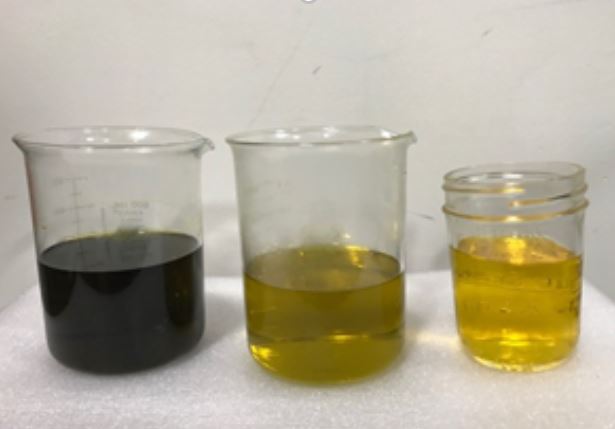Why is a color removal step important in cannabis production?
The color of cannabis oil can vary and is largely determined by the extraction process and concentration of chlorophyll in the leaves. After the clarification step, chlorophyll is not fully removed. A pigment within green plants, chlorophyll is not harmful, but its strong and earthy flavor contributes to unpleasant organoleptic characteristics to the finished product. Therefore, it is an important step in the process not only to achieve the desired golden hue but also to preserve the quality of the final product.
How do you remove color from cannabis oil?
Removing color resulting from chlorophyll whilst still preserving cannabinoids remains a challenge. Traditionally, this process includes adding activated carbon to extract, then manually filtering through a coarse filter. There are different methods available for activated carbon treatment including manual addition of carbon powder or granules and carbon packed columns. While manual carbon addition is inexpensive and effective, it does have its drawbacks. In addition to requiring special attention to operator’s health and safety, the process of manual carbon addition can be labor intensive and messy.
Activated Carbon Media for Filtration of Cannabis Oil?
The food and beverage industry widely uses powdered activated carbon (PAC) for adsorption applications. However, using bulk PAC has significant drawbacks ranging from handling bulk carbon powder, equipment cleaning, and time and costs associated with carbon removal from the process. The new food contact compliant Seitz® AKS FB immobilized carbon filter media addresses these concerns by combining activated carbon into a matrix of cellulosic fibers. Immobilized carbon media is paired with a downstream trap filter to prevent carbon particles from shedding downstream of the filter.
Seitz AKS FB Series depth filter sheets and SUPRAdisc™ filter modules were developed as a solution for color remediation and off-flavor removal in the cannabis extraction process. Pall's technology and expertise can help you achieve the light golden color desired of cannabis extracts, improve extract purity and protect downstream processes. Pall’s AKS carbon impregnated modules can improve throughput, yield and efficiency, maintain optimal process control and bring sustainable value to your production process. Learn more about our activated carbon-impregnated sheet media here.
As an alternative, carbon impregnated SUPRAdisc AKS FB lenticular modules for easier to handle and more hygienic carbon treatment. Used with ethanol and CO2 extractions, these modules fit directly into a sanitary stainless-steel housing solution. In AKS modules, carbon is integrated into the cellulose fiber matrix and allows maximum access to the adsorptive surface of the activated carbon. This maintains the adsorptive capacity and does not introduce any materials that might degrade or negatively impact the oil.
Benefits of SUPRAdisc AKS Modules for Cannabis Oil Producers
- Reduction of green color left from chlorophyll
- Easy and hygienic alternative to manual carbon process
- Enclosed assembly increases process security, preventing contamination risk when compared to traditional flat sheet filter assemblies.
- Yield increase as the enclosed assembly eliminates drip loss.
- Reduced carbon bleed or carryover.
- Tailored onsite or offsite support and process improvement recommendations from our SLS – global technical support team









